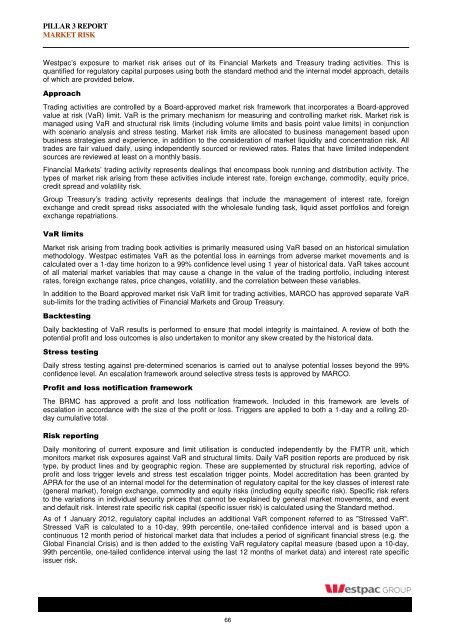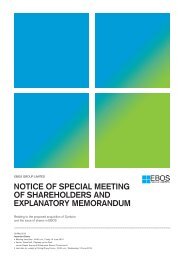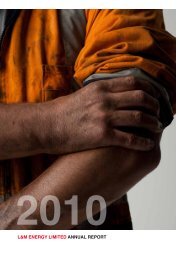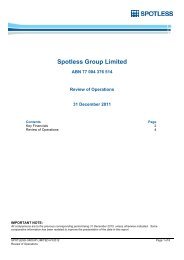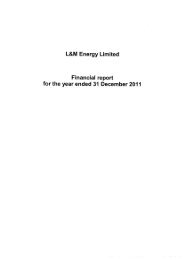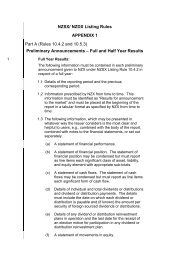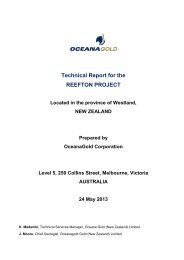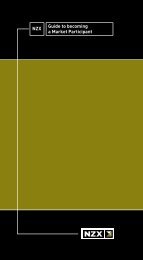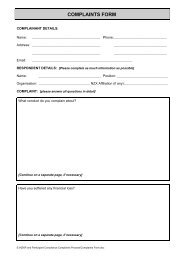Westpac Group Pillar 3 Report March 2013 - Iguana IR Sites
Westpac Group Pillar 3 Report March 2013 - Iguana IR Sites
Westpac Group Pillar 3 Report March 2013 - Iguana IR Sites
You also want an ePaper? Increase the reach of your titles
YUMPU automatically turns print PDFs into web optimized ePapers that Google loves.
PILLAR 3 REPORT<br />
MARKET RISK<br />
<strong>Westpac</strong>’s exposure to market risk arises out of its Financial Markets and Treasury trading activities. This is<br />
quantified for regulatory capital purposes using both the standard method and the internal model approach, details<br />
of which are provided below.<br />
Approach<br />
Trading activities are controlled by a Board-approved market risk framework that incorporates a Board-approved<br />
value at risk (VaR) limit. VaR is the primary mechanism for measuring and controlling market risk. Market risk is<br />
managed using VaR and structural risk limits (including volume limits and basis point value limits) in conjunction<br />
with scenario analysis and stress testing. Market risk limits are allocated to business management based upon<br />
business strategies and experience, in addition to the consideration of market liquidity and concentration risk. All<br />
trades are fair valued daily, using independently sourced or reviewed rates. Rates that have limited independent<br />
sources are reviewed at least on a monthly basis.<br />
Financial Markets’ trading activity represents dealings that encompass book running and distribution activity. The<br />
types of market risk arising from these activities include interest rate, foreign exchange, commodity, equity price,<br />
credit spread and volatility risk.<br />
<strong>Group</strong> Treasury’s trading activity represents dealings that include the management of interest rate, foreign<br />
exchange and credit spread risks associated with the wholesale funding task, liquid asset portfolios and foreign<br />
exchange repatriations.<br />
VaR limits<br />
Market risk arising from trading book activities is primarily measured using VaR based on an historical simulation<br />
methodology. <strong>Westpac</strong> estimates VaR as the potential loss in earnings from adverse market movements and is<br />
calculated over a 1-day time horizon to a 99% confidence level using 1 year of historical data. VaR takes account<br />
of all material market variables that may cause a change in the value of the trading portfolio, including interest<br />
rates, foreign exchange rates, price changes, volatility, and the correlation between these variables.<br />
In addition to the Board approved market risk VaR limit for trading activities, MARCO has approved separate VaR<br />
sub-limits for the trading activities of Financial Markets and <strong>Group</strong> Treasury.<br />
Backtesting<br />
Daily backtesting of VaR results is performed to ensure that model integrity is maintained. A review of both the<br />
potential profit and loss outcomes is also undertaken to monitor any skew created by the historical data.<br />
Stress testing<br />
Daily stress testing against pre-determined scenarios is carried out to analyse potential losses beyond the 99%<br />
confidence level. An escalation framework around selective stress tests is approved by MARCO.<br />
Profit and loss notification framework<br />
The BRMC has approved a profit and loss notification framework. Included in this framework are levels of<br />
escalation in accordance with the size of the profit or loss. Triggers are applied to both a 1-day and a rolling 20-<br />
day cumulative total.<br />
Risk reporting<br />
Daily monitoring of current exposure and limit utilisation is conducted independently by the FMTR unit, which<br />
monitors market risk exposures against VaR and structural limits. Daily VaR position reports are produced by risk<br />
type, by product lines and by geographic region. These are supplemented by structural risk reporting, advice of<br />
profit and loss trigger levels and stress test escalation trigger points. Model accreditation has been granted by<br />
APRA for the use of an internal model for the determination of regulatory capital for the key classes of interest rate<br />
(general market), foreign exchange, commodity and equity risks (including equity specific risk). Specific risk refers<br />
to the variations in individual security prices that cannot be explained by general market movements, and event<br />
and default risk. Interest rate specific risk capital (specific issuer risk) is calculated using the Standard method.<br />
As of 1 January 2012, regulatory capital includes an additional VaR component referred to as "Stressed VaR".<br />
Stressed VaR is calculated to a 10-day, 99th percentile, one-tailed confidence interval and is based upon a<br />
continuous 12 month period of historical market data that includes a period of significant financial stress (e.g. the<br />
Global Financial Crisis) and is then added to the existing VaR regulatory capital measure (based upon a 10-day,<br />
99th percentile, one-tailed confidence interval using the last 12 months of market data) and interest rate specific<br />
issuer risk.<br />
66


